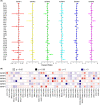Pan-cancer analysis of oncogenic role of insulin-like growth factor-binding proteins and validation in ovarian cancer
- PMID: 37199034
- PMCID: PMC10358252
- DOI: 10.1002/cam4.6073
Pan-cancer analysis of oncogenic role of insulin-like growth factor-binding proteins and validation in ovarian cancer
Abstract
Background: Numerous studies have shown that the insulin-like growth factor (IGF) pathway is highly associated with tumor initial and progression in several tumors. However, compared with IGF1/1R and IGF2/2R, insufficient studies have focused on IGF-binding proteins (IGFBPs).
Methods: The GDC TCGA and GTEx data of 33 cancers, TCGA pan-cancer immune phenotypes, tumor mutation burdens, and the copy number alterations of IGFBPs were extracted. Next, the prognostic value of IGFBPs was analyzed based on a univariate Cox analysis. Additionally, the ESTIMATE algorithm was used to calculate stromal and immune scores and tumor purity, and the CIBERSORT algorithm was used to estimate tumor-infiltrating immunocyte levels. Ultimately, the correlation between IGFBP expression and cancer hallmark pathways was estimated with a Spearman analysis.
Results: The expression of IGFBPs was differentially expressed and correlated with prognosis in specific cancers. IGFBPs may operate as biological markers for carcinogenesis and progression and as prognostic biomarkers. Additionally, IGFBP5 has been proved that promotes the invasion and migration of ovarian cancer.
Conclusions: In general, IGFBPs can serve as predictable biomarkers and potential therapeutic targets for specific tumors. Our results could provide underlying targets for the design of laboratory experiments to elucidate the mechanism of IGFBPs in cancers and identify IGFBP5 as a prognostic factor in ovarian cancers.
Keywords: IGF-binding proteins; cancer hallmark; ovarian cancer.
© 2023 The Authors. Cancer Medicine published by John Wiley & Sons Ltd.
Conflict of interest statement
The authors declare no competing interests.
Figures








Similar articles
-
IGFBPs modulate IGF-I- and high glucose-controlled growth of human retinal endothelial cells.J Endocrinol. 2001 Nov;171(2):273-84. doi: 10.1677/joe.0.1710273. J Endocrinol. 2001. PMID: 11691647
-
Expression characteristics and their functional role of IGFBP gene family in pan-cancer.BMC Cancer. 2023 Apr 24;23(1):371. doi: 10.1186/s12885-023-10832-3. BMC Cancer. 2023. PMID: 37088808 Free PMC article.
-
Cellular distribution and ontogeny of insulin-like growth factors (IGFs) and IGF binding protein messenger RNAs and peptides in developing rat pancreas.J Endocrinol. 1999 Feb;160(2):305-17. doi: 10.1677/joe.0.1600305. J Endocrinol. 1999. PMID: 9924201
-
Role of insulin-like growth factor-binding proteins in the pathophysiology and tumorigenesis of gastroesophageal cancers.Tumour Biol. 2015 Nov;36(11):8247-57. doi: 10.1007/s13277-015-3972-3. Epub 2015 Sep 14. Tumour Biol. 2015. PMID: 26369544 Review.
-
Nuclear localization and actions of the insulin-like growth factor 1 (IGF-1) system components: Transcriptional regulation and DNA damage response.Mutat Res Rev Mutat Res. 2020 Apr-Jun;784:108307. doi: 10.1016/j.mrrev.2020.108307. Epub 2020 Feb 27. Mutat Res Rev Mutat Res. 2020. PMID: 32430099 Review.
Cited by
-
Targeting miR-103a-3p/IGFBP5 axis: a potential therapeutic strategy for gastric cancer progression.Discov Oncol. 2025 Apr 22;16(1):591. doi: 10.1007/s12672-025-02390-w. Discov Oncol. 2025. PMID: 40263134 Free PMC article.
-
Preadipocyte-induced upregulation of IGFBP5 enhances ovarian cancer tumorigenesis via CREB signaling.iScience. 2025 Jun 28;28(8):113034. doi: 10.1016/j.isci.2025.113034. eCollection 2025 Aug 15. iScience. 2025. PMID: 40734678 Free PMC article.
References
Publication types
MeSH terms
Substances
LinkOut - more resources
Full Text Sources
Medical
Miscellaneous

